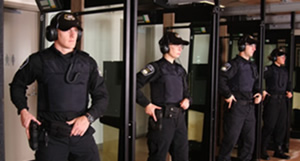Workplace Air Monitoring of Police Firing Ranges
Synergy Environmental Solutions has recently completed a project of Workplace Air Monitoring of Police Firing Ranges. The project measured the exposure of armed officers to hazardous substances. The work was carried out to fulfill the requirements of Chapter 11 of the Handbook of Police Range Safety and measured the exposure of officers to carbon monoxide and lead during a qualification shoot in an indoor police firing range.

Inhalation and ingestion of lead can be hazardous to health. When a weapon is fired, the hot gases produced by the propellant burns the lead from the base of the bullet, producing lead fume. Lead particles are also stripped from unjacketed bullets as they travel down the barrel and are subsequently released into the air around the firer.
Carbon Monoxide (CO) is released into the air each time a weapon is discharged. The amount of CO expelled is dependent upon the ammunition cartridge used. These gasses are light and will disperse in the direction of any air flow. This hazard generally only needs to be considered in ranges that have no mechanical or natural ventilation and in all police firing ranges with small enclosed firing points.
Synergy are pleased to report that the officers tested in the police firing range had exposures of carbon monoxide below both the Long Term and Short Term Exposure Limits and the levels of lead exposure were all classed as insignificant under the Control of Lead At Work (CLAW) regulations.
For further information about the workplace air monitoring services provided by Synergy Environmental Solutions visit our workplace air monitoring page
Call us today on: 01782 614236 or email us at: [email protected]


